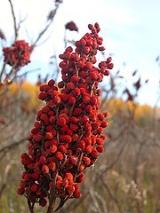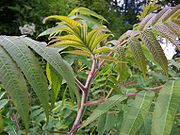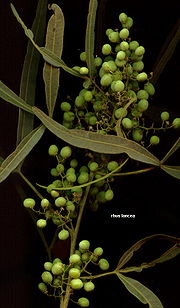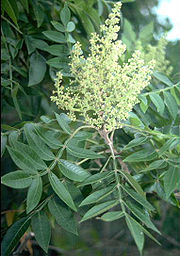
Sumac
Encyclopedia
Sumac is any one of approximately 250 species of flowering plant
s in the genus
Rhus and related genera, in the family Anacardiaceae
. Sumacs grow in subtropical
and temperate
regions throughout the world, especially in Africa
and North America
.
Sumacs are shrub
s and small tree
s that can reach a height of 1–10 m (3.3–32.8 ft). The leaves
are spirally arranged; they are usually pinnately compound
, though some species have trifoliate or simple leaves. The flower
s are in dense panicle
s or spikes 5–30 cm (2–11.8 in) long, each flower very small, greenish, creamy white or red, with five petals. The fruit
s form dense clusters of reddish drupe
s called sumac bobs. The dried drupes of some species are ground to produce a tangy purple spice.
Sumacs propagate both by seed
(spread by bird
s and other animals through their droppings
), and by new shoot
s from rhizome
s, forming large clonal colonies
.
The word sumac traces its etymology from Old French sumac (13th century), from Medieval Latin sumach, from Arabic , from Syriac
- meaning "red."
s) of the genus Rhus are ground into a deep-red or purple powder used as a spice
in Middle Eastern cuisine
to add a lemon
y taste to salads or meat. In Arab cuisine
, it is used as a garnish on meze
dishes such as hummus
and is added to salads in the Levant
. In Iranian
(Persian and Kurdish
) cuisine, sumac is added to rice or kebab
. In Turkish cuisine
, it is added to salad-servings of kebabs and lahmacun
. Rhus coriaria
is used in the spice mixture za'atar
.
In North America, the Smooth Sumac (R. glabra
) and the Staghorn Sumac (R. typhina
) are sometimes used to make a beverage termed "sumac-ade," "Indian lemonade" or "rhus juice". This drink is made by soaking the drupes in cool water, rubbing them to extract the essence, straining the liquid through a cotton cloth and sweetening it. Native Americans also used the leaves and drupes of the Smooth and Staghorn Sumacs combined with tobacco
in traditional smoking mixtures.
Species including the Fragrant Sumac (R. aromatica
), the Littleleaf Sumac (R. microphylla
), the Skunkbush Sumac (R. trilobata), the Smooth Sumac and the Staghorn Sumac are grown for ornament
, either as the wild types or as cultivar
s.
The leaves of certain sumacs yield tannin
(mostly pyrogallol-type), a substance used in vegetable tanning
. Notable sources include the leaves of R. coriaria, Chinese gall on R. chinensis
, and wood and roots of R. pentaphylla
. Leather
tanned with sumac is flexible, light in weight, and light in color. One type of leather made with sumac tannins is morocco leather
.
Sumac was used as a treatment for half a dozen different ailments in medieval medicine, primarily in Islamic countries (where sumac was more readily available than in Europe). An 11th-century shipwreck off the coast of Rhodes
, excavated by archeologists in the 1970s, contained commercial quantities of sumac drupes. These could have been intended for use as medicine, or as a culinary spice, or as a dye.
Some beekeepers use dried sumac bobs as a source of fuel for their smokers.
Dried sumac wood fluoresces
under long-wave ultraviolet
radiation, commonly known as black light
.
(Rhus toxicodendron, syn.Toxicodendron radicans), Poison oak (Rhus diversiloba, syn. Toxicodendron diversilobum) and Poison sumac
(Rhus vernix, syn. Toxicodendron vernix), have the allergen urushiol
and can cause severe allergic reactions. Poison sumac may be identified by its white drupe
s.
Mowing of sumac is not a good control measure, since the wood is springy, resulting in jagged, sharp pointed stumps when mowed. The plant will quickly recover with new growth after mowing. Goats have long been considered an efficient and quick removal method as they eat the bark, which helps prevent new shoots.




 At times Rhus has held over 250 species. Recent molecular phylogeny
At times Rhus has held over 250 species. Recent molecular phylogeny
research suggests breaking Rhus sensu lato into Actinocheita, Baronia, Cotinus, Malosma
, Searsia, Toxicodendron
, and Rhus sensu stricto. If this is done, about 35 species would remain in Rhus. However, the data are not yet clear enough to settle the proper placement of all species into these genera.
Flowering plant
The flowering plants , also known as Angiospermae or Magnoliophyta, are the most diverse group of land plants. Angiosperms are seed-producing plants like the gymnosperms and can be distinguished from the gymnosperms by a series of synapomorphies...
s in the genus
Genus
In biology, a genus is a low-level taxonomic rank used in the biological classification of living and fossil organisms, which is an example of definition by genus and differentia...
Rhus and related genera, in the family Anacardiaceae
Anacardiaceae
Anacardiaceae are a family of flowering plants bearing fruits that are drupes and in some cases producing urushiol, an irritant. Anacardiaceae include numerous genera with several of economic importance. Notable plants in this family include cashew , mango, poison ivy, sumac, smoke tree, and marula...
. Sumacs grow in subtropical
Subtropics
The subtropics are the geographical and climatical zone of the Earth immediately north and south of the tropical zone, which is bounded by the Tropic of Cancer and the Tropic of Capricorn, at latitudes 23.5°N and 23.5°S...
and temperate
Temperate
In geography, temperate or tepid latitudes of the globe lie between the tropics and the polar circles. The changes in these regions between summer and winter are generally relatively moderate, rather than extreme hot or cold...
regions throughout the world, especially in Africa
Africa
Africa is the world's second largest and second most populous continent, after Asia. At about 30.2 million km² including adjacent islands, it covers 6% of the Earth's total surface area and 20.4% of the total land area...
and North America
North America
North America is a continent wholly within the Northern Hemisphere and almost wholly within the Western Hemisphere. It is also considered a northern subcontinent of the Americas...
.
Sumacs are shrub
Shrub
A shrub or bush is distinguished from a tree by its multiple stems and shorter height, usually under 5–6 m tall. A large number of plants may become either shrubs or trees, depending on the growing conditions they experience...
s and small tree
Tree
A tree is a perennial woody plant. It is most often defined as a woody plant that has many secondary branches supported clear of the ground on a single main stem or trunk with clear apical dominance. A minimum height specification at maturity is cited by some authors, varying from 3 m to...
s that can reach a height of 1–10 m (3.3–32.8 ft). The leaves
Leaf
A leaf is an organ of a vascular plant, as defined in botanical terms, and in particular in plant morphology. Foliage is a mass noun that refers to leaves as a feature of plants....
are spirally arranged; they are usually pinnately compound
Pinnate
Pinnate is a term used to describe feather-like or multi-divided features arising from both sides of a common axis in plant or animal structures, and comes from the Latin word pinna meaning "feather", "wing", or "fin". A similar term is pectinate, which refers to a comb-like arrangement of parts...
, though some species have trifoliate or simple leaves. The flower
Flower
A flower, sometimes known as a bloom or blossom, is the reproductive structure found in flowering plants . The biological function of a flower is to effect reproduction, usually by providing a mechanism for the union of sperm with eggs...
s are in dense panicle
Panicle
A panicle is a compound raceme, a loose, much-branched indeterminate inflorescence with pedicellate flowers attached along the secondary branches; in other words, a branched cluster of flowers in which the branches are racemes....
s or spikes 5–30 cm (2–11.8 in) long, each flower very small, greenish, creamy white or red, with five petals. The fruit
Fruit
In broad terms, a fruit is a structure of a plant that contains its seeds.The term has different meanings dependent on context. In non-technical usage, such as food preparation, fruit normally means the fleshy seed-associated structures of certain plants that are sweet and edible in the raw state,...
s form dense clusters of reddish drupe
Drupe
In botany, a drupe is a fruit in which an outer fleshy part surrounds a shell of hardened endocarp with a seed inside. These fruits develop from a single carpel, and mostly from flowers with superior ovaries...
s called sumac bobs. The dried drupes of some species are ground to produce a tangy purple spice.
Sumacs propagate both by seed
Seed
A seed is a small embryonic plant enclosed in a covering called the seed coat, usually with some stored food. It is the product of the ripened ovule of gymnosperm and angiosperm plants which occurs after fertilization and some growth within the mother plant...
(spread by bird
Bird
Birds are feathered, winged, bipedal, endothermic , egg-laying, vertebrate animals. Around 10,000 living species and 188 families makes them the most speciose class of tetrapod vertebrates. They inhabit ecosystems across the globe, from the Arctic to the Antarctic. Extant birds range in size from...
s and other animals through their droppings
Feces
Feces, faeces, or fæces is a waste product from an animal's digestive tract expelled through the anus or cloaca during defecation.-Etymology:...
), and by new shoot
Shoot
Shoots are new plant growth, they can include stems, flowering stems with flower buds, and leaves. The new growth from seed germination that grows upward is a shoot where leaves will develop...
s from rhizome
Rhizome
In botany and dendrology, a rhizome is a characteristically horizontal stem of a plant that is usually found underground, often sending out roots and shoots from its nodes...
s, forming large clonal colonies
Clonal colony
A clonal colony or genet is a group of genetically identical individuals that have grown in a given location, all originating vegetatively from a single ancestor. In plants, an individual in such a population is referred to as a ramet...
.
The word sumac traces its etymology from Old French sumac (13th century), from Medieval Latin sumach, from Arabic , from Syriac
Syriac language
Syriac is a dialect of Middle Aramaic that was once spoken across much of the Fertile Crescent. Having first appeared as a script in the 1st century AD after being spoken as an unwritten language for five centuries, Classical Syriac became a major literary language throughout the Middle East from...
- meaning "red."
Cultivation and uses
The fruits (drupeDrupe
In botany, a drupe is a fruit in which an outer fleshy part surrounds a shell of hardened endocarp with a seed inside. These fruits develop from a single carpel, and mostly from flowers with superior ovaries...
s) of the genus Rhus are ground into a deep-red or purple powder used as a spice
Spice
A spice is a dried seed, fruit, root, bark, or vegetative substance used in nutritionally insignificant quantities as a food additive for flavor, color, or as a preservative that kills harmful bacteria or prevents their growth. It may be used to flavour a dish or to hide other flavours...
in Middle Eastern cuisine
Middle Eastern cuisine
Middle-Eastern cuisine, West Asian cuisine, or in some place in the United States, Persian-Mediterranean cuisine is the cuisine of the various countries and peoples of the Middle East . The cuisine of the region is diverse while having a degree of homogeneity...
to add a lemon
Lemon
The lemon is both a small evergreen tree native to Asia, and the tree's ellipsoidal yellow fruit. The fruit is used for culinary and non-culinary purposes throughout the world – primarily for its juice, though the pulp and rind are also used, mainly in cooking and baking...
y taste to salads or meat. In Arab cuisine
Arab cuisine
Arab cuisine is defined as the various regional cuisines spanning the Arab World, from Morocco and Tunisia to Saudi Arabia, and incorporating Levantine, Egyptian .-History:...
, it is used as a garnish on meze
Meze
Meze or mezze is a selection of small dishes served in the Mediterranean and Middle East as dinner or lunch, with or without drinks. In Levantine cuisines and in the Caucasus region, meze is served at the beginning of all large-scale meals....
dishes such as hummus
Hummus
Hummus is high in iron and vitamin C and also has significant amounts of folate and vitamin B6. The chickpeas make it a good source of protein and dietary fiber; the tahini consists mostly of sesame seeds, which are an excellent source of the amino acid methionine, complementing the proteins in the...
and is added to salads in the Levant
Levant
The Levant or ) is the geographic region and culture zone of the "eastern Mediterranean littoral between Anatolia and Egypt" . The Levant includes most of modern Lebanon, Syria, Jordan, Israel, the Palestinian territories, and sometimes parts of Turkey and Iraq, and corresponds roughly to the...
. In Iranian
Iranian cuisine
Iranian cuisine is diverse, with each province featuring dishes, culinary traditions and styles distinct to its region.It includes a wide variety of foods ranging from chelo kabab , khoresht Iranian cuisine is diverse, with each province featuring dishes, culinary traditions and styles distinct to...
(Persian and Kurdish
Kurdish cuisine
Kurdish cuisine consists of a wide variety of foods prepared by the Kurdish people that have got many traditions from their homeland, Kurdistan.-Culinary customs:...
) cuisine, sumac is added to rice or kebab
Kebab
Kebab is a wide variety of meat dishes originating in Middle East and later on adopted by the Middle East, and Asia Minor, and now found worldwide. In English, kebab with no qualification generally refers more specifically to shish kebab served on the skewer...
. In Turkish cuisine
Turkish cuisine
Turkish cuisine is largely the heritage of Ottoman cuisine, which can be described as a fusion and refinement of Central Asian, Middle Eastern and Balkan cuisines. Turkish cuisine has in turn influenced those and other neighbouring cuisines, including that of western Europe...
, it is added to salad-servings of kebabs and lahmacun
Lahmacun
Lahmacun or lahmajoun , from , , "meat with dough", is an item of prepared food originating in the early Syrian cuisine of the Levant, consisting of a round, thin piece of dough topped with minced meat...
. Rhus coriaria
Rhus coriaria
Rhus coriaria, commonly called Elm-Leaved Sumach or Tanner's Sumach is a deciduous shrub to small tree in the Anacardiaceae or Cashew family, native to southern Europe. The dried fruit are used as a spice, particularly in combination with other spices in the mixture called Za'atar.- Uses :Caution...
is used in the spice mixture za'atar
Za'atar
Za'atar is a generic name for a family of related Middle Eastern herbs from the genera Origanum , Calamintha , Thymus vulgaris and Satureja . It is also the name for a condiment made from the dried herb, mixed together with sesame seeds, dried sumac, and often salt, as well as other spices...
.
In North America, the Smooth Sumac (R. glabra
Rhus glabra
Rhus glabra is a species of sumac in the family Anacardiaceae, native to North America, from southern Quebec west to southern British Columbia in Canada, and south to northern Florida and Arizona in the United States and Tamaulipas in northeastern Mexico.One of the easiest shrubs to identify...
) and the Staghorn Sumac (R. typhina
Rhus typhina
The Staghorn Sumac is a deciduous shrub to small tree in the Anacardiaceae or Cashew family, native to eastern North America...
) are sometimes used to make a beverage termed "sumac-ade," "Indian lemonade" or "rhus juice". This drink is made by soaking the drupes in cool water, rubbing them to extract the essence, straining the liquid through a cotton cloth and sweetening it. Native Americans also used the leaves and drupes of the Smooth and Staghorn Sumacs combined with tobacco
Tobacco
Tobacco is an agricultural product processed from the leaves of plants in the genus Nicotiana. It can be consumed, used as a pesticide and, in the form of nicotine tartrate, used in some medicines...
in traditional smoking mixtures.
Species including the Fragrant Sumac (R. aromatica
Rhus aromatica
Rhus aromatica is a plant species in the family Anacardiaceae native to Canada and the United States....
), the Littleleaf Sumac (R. microphylla
Rhus microphylla
Rhus microphylla is a species of sumac in the family Anacardiaceae, native to North America, in the southwestern United States and northern and central Mexico, from central and western Texas, southern New Mexico, central and northern regions of the Mexican Altiplano-, and extreme...
), the Skunkbush Sumac (R. trilobata), the Smooth Sumac and the Staghorn Sumac are grown for ornament
Ornamental plant
Ornamental plants are plants that are grown for decorative purposes in gardens and landscape design projects, as house plants, for cut flowers and specimen display...
, either as the wild types or as cultivar
Cultivar
A cultivar'Cultivar has two meanings as explained under Formal definition. When used in reference to a taxon, the word does not apply to an individual plant but to all those plants sharing the unique characteristics that define the cultivar. is a plant or group of plants selected for desirable...
s.
The leaves of certain sumacs yield tannin
Tannin
A tannin is an astringent, bitter plant polyphenolic compound that binds to and precipitates proteins and various other organic compounds including amino acids and alkaloids.The term tannin refers to the use of...
(mostly pyrogallol-type), a substance used in vegetable tanning
Tanning
Tanning is the making of leather from the skins of animals which does not easily decompose. Traditionally, tanning used tannin, an acidic chemical compound from which the tanning process draws its name . Coloring may occur during tanning...
. Notable sources include the leaves of R. coriaria, Chinese gall on R. chinensis
Rhus chinensis
Rhus chinensis, the Chinese sumac or nutgall tree, is a plant species in the genus Rhus.The species is used to produce galls, called Chinese gall, Galla Chinensis or Wu Bei Zi in Chinese, which are rich in gallotannins, a type of hydrolysable tannins...
, and wood and roots of R. pentaphylla
Rhus pentaphylla
Rhus pentaphylla, the tizra tree, is a sumac shrub or small tree species in the genus Rhus found in North Africa, especially in Morroco. Its roots and heartwood are used to produce tannin of the condensed type....
. Leather
Leather
Leather is a durable and flexible material created via the tanning of putrescible animal rawhide and skin, primarily cattlehide. It can be produced through different manufacturing processes, ranging from cottage industry to heavy industry.-Forms:...
tanned with sumac is flexible, light in weight, and light in color. One type of leather made with sumac tannins is morocco leather
Morocco leather
Morocco leather is a leather made from goatskin, dyed red on the grain side and then tanned by hand to bring up the grain in a bird's-eye pattern....
.
Sumac was used as a treatment for half a dozen different ailments in medieval medicine, primarily in Islamic countries (where sumac was more readily available than in Europe). An 11th-century shipwreck off the coast of Rhodes
Rhodes
Rhodes is an island in Greece, located in the eastern Aegean Sea. It is the largest of the Dodecanese islands in terms of both land area and population, with a population of 117,007, and also the island group's historical capital. Administratively the island forms a separate municipality within...
, excavated by archeologists in the 1970s, contained commercial quantities of sumac drupes. These could have been intended for use as medicine, or as a culinary spice, or as a dye.
Some beekeepers use dried sumac bobs as a source of fuel for their smokers.
Dried sumac wood fluoresces
Fluorescence
Fluorescence is the emission of light by a substance that has absorbed light or other electromagnetic radiation of a different wavelength. It is a form of luminescence. In most cases, emitted light has a longer wavelength, and therefore lower energy, than the absorbed radiation...
under long-wave ultraviolet
Ultraviolet
Ultraviolet light is electromagnetic radiation with a wavelength shorter than that of visible light, but longer than X-rays, in the range 10 nm to 400 nm, and energies from 3 eV to 124 eV...
radiation, commonly known as black light
Black light
A black light, also referred to as a UV light, ultraviolet light, or Wood's lamp, is a lamp that emits ultraviolet radiation in the long-wave range, and little visible light...
.
Toxicity and control
Some species, such as Poison ivyPoison ivy
Toxicodendron radicans, better known as poison ivy , is a poisonous North American plant that is well known for its production of urushiol, a clear liquid compound found within the sap of the plant that causes an itching rash in most people who touch it...
(Rhus toxicodendron, syn.Toxicodendron radicans), Poison oak (Rhus diversiloba, syn. Toxicodendron diversilobum) and Poison sumac
Poison Sumac
Poison sumac is a woody shrub or small tree growing to 7 m tall. All parts of the plant contain a resin called urushiol that causes skin and mucous membrane irritation to humans...
(Rhus vernix, syn. Toxicodendron vernix), have the allergen urushiol
Urushiol
Urushiol is an oily organic allergen found in plants of the family Anacardiaceae, especially Toxicodendron spp. . It causes an allergic skin rash on contact, known as urushiol-induced contact dermatitis...
and can cause severe allergic reactions. Poison sumac may be identified by its white drupe
Drupe
In botany, a drupe is a fruit in which an outer fleshy part surrounds a shell of hardened endocarp with a seed inside. These fruits develop from a single carpel, and mostly from flowers with superior ovaries...
s.
Mowing of sumac is not a good control measure, since the wood is springy, resulting in jagged, sharp pointed stumps when mowed. The plant will quickly recover with new growth after mowing. Goats have long been considered an efficient and quick removal method as they eat the bark, which helps prevent new shoots.
Taxonomy





Molecular phylogeny
Molecular phylogenetics is the analysis of hereditary molecular differences, mainly in DNA sequences, to gain information on an organism's evolutionary relationships. The result of a molecular phylogenetic analysis is expressed in a phylogenetic tree...
research suggests breaking Rhus sensu lato into Actinocheita, Baronia, Cotinus, Malosma
Malosma
Malosma is a plant genus which contains only a single species, Malosma laurina, with the common names Laurel sumac and Lentisco ....
, Searsia, Toxicodendron
Toxicodendron
Toxicodendron a genus of flowering plants in the sumac family, Anacardiaceae. It contains woody trees, shrubs and vines, including poison ivy, poison oak, and the lacquer tree. All members of the genus produce the skin-irritating oil urushiol, which can cause a severe allergic reaction...
, and Rhus sensu stricto. If this is done, about 35 species would remain in Rhus. However, the data are not yet clear enough to settle the proper placement of all species into these genera.
Selected species
Africa:
|
Asia:
Australia, Pacific:
Mediterranean Basin:
Eastern North America:
Western North America:
Mexico and Central America:
|

